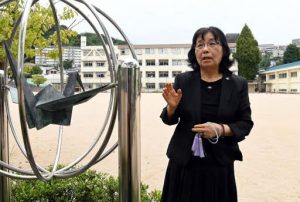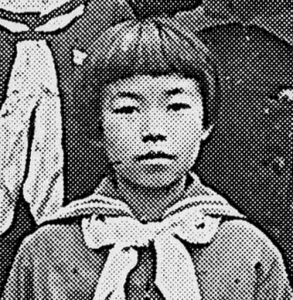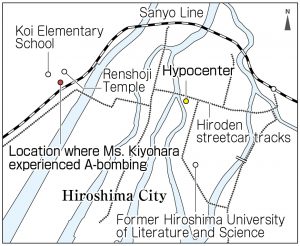Survivors’ Stories: Fumiko Kiyohara, 84, Nishi Ward, Hiroshima—Remains in schoolyard part of everyday life
Sep. 15, 2020
by Yuji Yamamoto, Staff Writer
Fumiko Kiyohara, 84, experienced the atomic bombing when she was nine years old. She vividly recalled the devastation at that time while standing in the schoolyard of her alma mater Koi Elementary School in Hiroshima’s Nishi Ward and said, “Trenches were dug in the schoolyard, into which corpses were thrown like mere ‘objects.’” Ten years ago, she and her classmates erected a peace monument there, based on their strong belief that war must never be waged.
Her family lived in Renshoji Temple, which also operated a nursery school. In those days, the school buildings of what used to be Koi National School were provided to the Japanese military, meaning that students attended classes in separate locations.
Ms. Kiyohara was then a fourth-grade student in elementary school. She still remembers the tremendous shock wave that suddenly knocked her off her feet on the morning of August 6, 1945, the date the atomic bomb was dropped on Hiroshima. At the time, she was playing a game using beanbags together with her friends near Asahiyama Shrine, which served as a branch school where some of the classes were held. When she came to, she found herself in a field without her bag and wooden geta shoes. Although she was far away, 2.5 kilometers from the hypocenter, she had the sense she had been blown 100 meters in the air, like the leaf of a tree.
Not seriously injured, she returned home barefoot. When she reached close to her home, she witnessed lines of people with burns over their entire bodies escaping the city. The main hall of the temple filled up with the wounded. No matter how hard her mother Hideko tried, there was nothing she could do. A nursery school girl was caressed in the arms of a nursery school teacher. Blood dripped from the girl, and her leg, which hung loosely, was connected to her body only by skin. Later, Ms. Kiyohara heard that the girl had died during the night.
Despite suffering broken bones, Ms. Kiyohara’s father, Takao, returned home that day on his own from Hiroshima University of Literature and Science (now Hiroshima University), where he had been helping with house demolition work for the war effort. Her family left their home to go and live with relatives in Kurashige (now part of Saeki Ward). That night, the sky over the city center turned bright red from all the fires.
When Ms. Kiyohara returned to Renshoji Temple after a week or so, the wounded were still being housed there. When some died, adults carried them on a large, two-wheeled cart to Koi National School, where the corpses were disposed of into seven trenches dug in the schoolyard and burned. As there was not enough firewood, some of the bodies were left only half-burned. After the school reopened later, remains were sometimes discovered in the schoolyard, which after a time failed to surprise her. She said, “I had become used to it.”
However, every time she recalls the last moments of a certain male student, whose story she had heard from her mother, she is filled with sorrow. He had said with his face swollen from burns, “Please tell my mother I’m here.” He died then without anyone knowing his name. He is thought to have been a student at Hiroshima Municipal Middle School (now Motomachi High School). She heard this information from a graduate of the same school who visited her later. Ms. Kiyohara said, “He seems to have died a terrible death.”
After the war, Ms. Kiyohara graduated from Suzugamine Girls’ Junior High and High School and married her husband Tetsuya, 89, in 1958. She gave birth to three children. She now belongs to a choir and, as a member of the group, sings the “Hiroshima Peace Song” at the Hiroshima Peace Memorial Ceremony on August 6 every year.
As she mourned the A-bombing victims at the temple, Ms. Kiyohara was always aware of the remains of those cremated in the schoolyard. After being buried there, the remains were transferred to the City’s Memorial Monument for the War Victims (the present-day Atomic Bomb Memorial Mound in Hiroshima Peace Memorial Park) in 1949. Although it is said that the remains of about 2,000 victims were moved, the exact number is unknown. Ms. Kiyohara wonders if some remain in the schoolyard even to this day.
With this in mind, Ms. Kiyohara and her classmates built the monument in 2010. The monument’s design includes folded cranes inlaid onto a world map that appear about to fly away from Hiroshima. The monument is also decorated with ceramic school uniform buttons sent by graduates of the former Hiroshima Municipal Middle School. Ms. Kiyohara and her schoolmates inserted A-bomb memoirs and various other items in a time capsule and left it there for future generations.
Ms. Kiyohara says, “Nothing is more foolish than war, in which people kill each other. Bringing up children to be kind and considerate is the first step toward building a peaceful society.” Her gentle gaze was vested with power.
(Originally published on September 15, 2020)
Monument at former school speaks to A-bombing horror
Fumiko Kiyohara, 84, experienced the atomic bombing when she was nine years old. She vividly recalled the devastation at that time while standing in the schoolyard of her alma mater Koi Elementary School in Hiroshima’s Nishi Ward and said, “Trenches were dug in the schoolyard, into which corpses were thrown like mere ‘objects.’” Ten years ago, she and her classmates erected a peace monument there, based on their strong belief that war must never be waged.
Her family lived in Renshoji Temple, which also operated a nursery school. In those days, the school buildings of what used to be Koi National School were provided to the Japanese military, meaning that students attended classes in separate locations.
Ms. Kiyohara was then a fourth-grade student in elementary school. She still remembers the tremendous shock wave that suddenly knocked her off her feet on the morning of August 6, 1945, the date the atomic bomb was dropped on Hiroshima. At the time, she was playing a game using beanbags together with her friends near Asahiyama Shrine, which served as a branch school where some of the classes were held. When she came to, she found herself in a field without her bag and wooden geta shoes. Although she was far away, 2.5 kilometers from the hypocenter, she had the sense she had been blown 100 meters in the air, like the leaf of a tree.
Not seriously injured, she returned home barefoot. When she reached close to her home, she witnessed lines of people with burns over their entire bodies escaping the city. The main hall of the temple filled up with the wounded. No matter how hard her mother Hideko tried, there was nothing she could do. A nursery school girl was caressed in the arms of a nursery school teacher. Blood dripped from the girl, and her leg, which hung loosely, was connected to her body only by skin. Later, Ms. Kiyohara heard that the girl had died during the night.
Despite suffering broken bones, Ms. Kiyohara’s father, Takao, returned home that day on his own from Hiroshima University of Literature and Science (now Hiroshima University), where he had been helping with house demolition work for the war effort. Her family left their home to go and live with relatives in Kurashige (now part of Saeki Ward). That night, the sky over the city center turned bright red from all the fires.
When Ms. Kiyohara returned to Renshoji Temple after a week or so, the wounded were still being housed there. When some died, adults carried them on a large, two-wheeled cart to Koi National School, where the corpses were disposed of into seven trenches dug in the schoolyard and burned. As there was not enough firewood, some of the bodies were left only half-burned. After the school reopened later, remains were sometimes discovered in the schoolyard, which after a time failed to surprise her. She said, “I had become used to it.”
However, every time she recalls the last moments of a certain male student, whose story she had heard from her mother, she is filled with sorrow. He had said with his face swollen from burns, “Please tell my mother I’m here.” He died then without anyone knowing his name. He is thought to have been a student at Hiroshima Municipal Middle School (now Motomachi High School). She heard this information from a graduate of the same school who visited her later. Ms. Kiyohara said, “He seems to have died a terrible death.”
After the war, Ms. Kiyohara graduated from Suzugamine Girls’ Junior High and High School and married her husband Tetsuya, 89, in 1958. She gave birth to three children. She now belongs to a choir and, as a member of the group, sings the “Hiroshima Peace Song” at the Hiroshima Peace Memorial Ceremony on August 6 every year.
As she mourned the A-bombing victims at the temple, Ms. Kiyohara was always aware of the remains of those cremated in the schoolyard. After being buried there, the remains were transferred to the City’s Memorial Monument for the War Victims (the present-day Atomic Bomb Memorial Mound in Hiroshima Peace Memorial Park) in 1949. Although it is said that the remains of about 2,000 victims were moved, the exact number is unknown. Ms. Kiyohara wonders if some remain in the schoolyard even to this day.
With this in mind, Ms. Kiyohara and her classmates built the monument in 2010. The monument’s design includes folded cranes inlaid onto a world map that appear about to fly away from Hiroshima. The monument is also decorated with ceramic school uniform buttons sent by graduates of the former Hiroshima Municipal Middle School. Ms. Kiyohara and her schoolmates inserted A-bomb memoirs and various other items in a time capsule and left it there for future generations.
Ms. Kiyohara says, “Nothing is more foolish than war, in which people kill each other. Bringing up children to be kind and considerate is the first step toward building a peaceful society.” Her gentle gaze was vested with power.
(Originally published on September 15, 2020)










